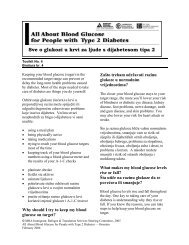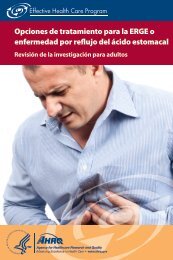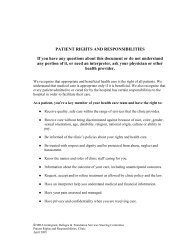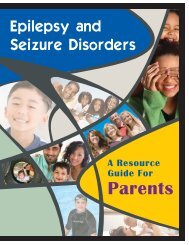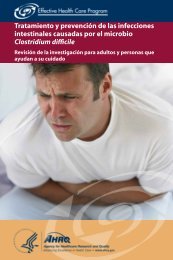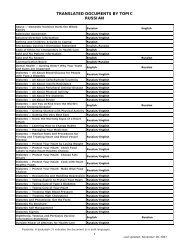cuidado del bebé care for baby - Health Translations
cuidado del bebé care for baby - Health Translations
cuidado del bebé care for baby - Health Translations
Create successful ePaper yourself
Turn your PDF publications into a flip-book with our unique Google optimized e-Paper software.
Although breast feeding is a “natural process,” it requires learning and practice. Be<br />
patient with yourself and your newborn. There is no set amount that the <strong>baby</strong> will take at<br />
each feeding. Some days your <strong>baby</strong> may seem unusually hungry and want to nurse more<br />
frequently. Your <strong>baby</strong> is probably getting enough milk if he is wetting at least six diapers<br />
in a day, having at least three (3) bowel movements and eating eight to twelve (8-12)<br />
times in 24 hours. Babies have a growth spurt at seven to ten (7-10) days and again when<br />
they are 28-30 days old. Your <strong>baby</strong> will eat more often <strong>for</strong> a day or so, then return to a<br />
regular pattern. If you are breast feeding, you will receive additional in<strong>for</strong>mation.<br />
Dando Fómula<br />
Los bebés alimentados con fórmula necesitan comer cada tres a cuatro (3-4) horas. Su<br />
bebé deberá comer por lo menos seis (6) veces al día. Tener al bebé en los brazos y el<br />
contacto cercano es necesario para el crecimiento y desarrollo normal. Cuando esté<br />
dándole de comer, mesa a su bebé en sus brazos manteniendo la cabeza un poco más alta<br />
que el pecho. Usted nunca debe de ponerle el biberón sin sostenerlo con su mano o dejar<br />
solo a su bebé cuando está comiendo. A lo mejor su médico le aconseja esterilizar los<br />
biberones y mamilas o lavarlas muy bien con agua caliente y jabón.<br />
Formula Feeding<br />
Bottle fed infants need to eat every three to four (3-4) hours. Your <strong>baby</strong> should eat at<br />
least six (6) times per day. Cuddling and close contact is necessary <strong>for</strong> normal growth and<br />
development. When feeding, cradle your <strong>baby</strong> in your arms holding the head slightly<br />
higher than the chest. You should never prop a bottle or leave your <strong>baby</strong> alone while<br />
feeding. You may be advised by your health <strong>care</strong> provider to sterilize bottles and nipples<br />
or to wash them thoroughly with hot soapy water.<br />
El médico de su bebé le dirá qué tipo de fórmula utilizar. Las fórmulas se venden en tres<br />
(3) diferentes <strong>for</strong>mas de prepararse:<br />
Your <strong>baby</strong>’s doctor will tell you what type of <strong>for</strong>mula to use. Formula is sold in three (3)<br />
different preparations:<br />
1. Lista para tomarse<br />
Ready to Feed<br />
2. Concentrada (agregar agua)<br />
Concentrated (add water)<br />
3. Polvo (agregar agua)<br />
Powder (add water)<br />
Prepare suficiente fórmula para veinticuatro (24) horas siguiendo las instrucciones en la<br />
etiqueta de la fórmula. La fórmula preparada y las latas abiertas deben de refrigerarse y<br />
usarse en las siguientes 24-48 horas. No utilice agua de pozo o manantial para preparar<br />
la fórmula. Antes de alimentar a su bebé, la fórmula debe estar a temperatura ambiente o<br />
© MHA Immigrant, Refugee & Translation Services Steering Committee, 2004<br />
Care <strong>for</strong> Mother— Spanish<br />
October 2004<br />
13



